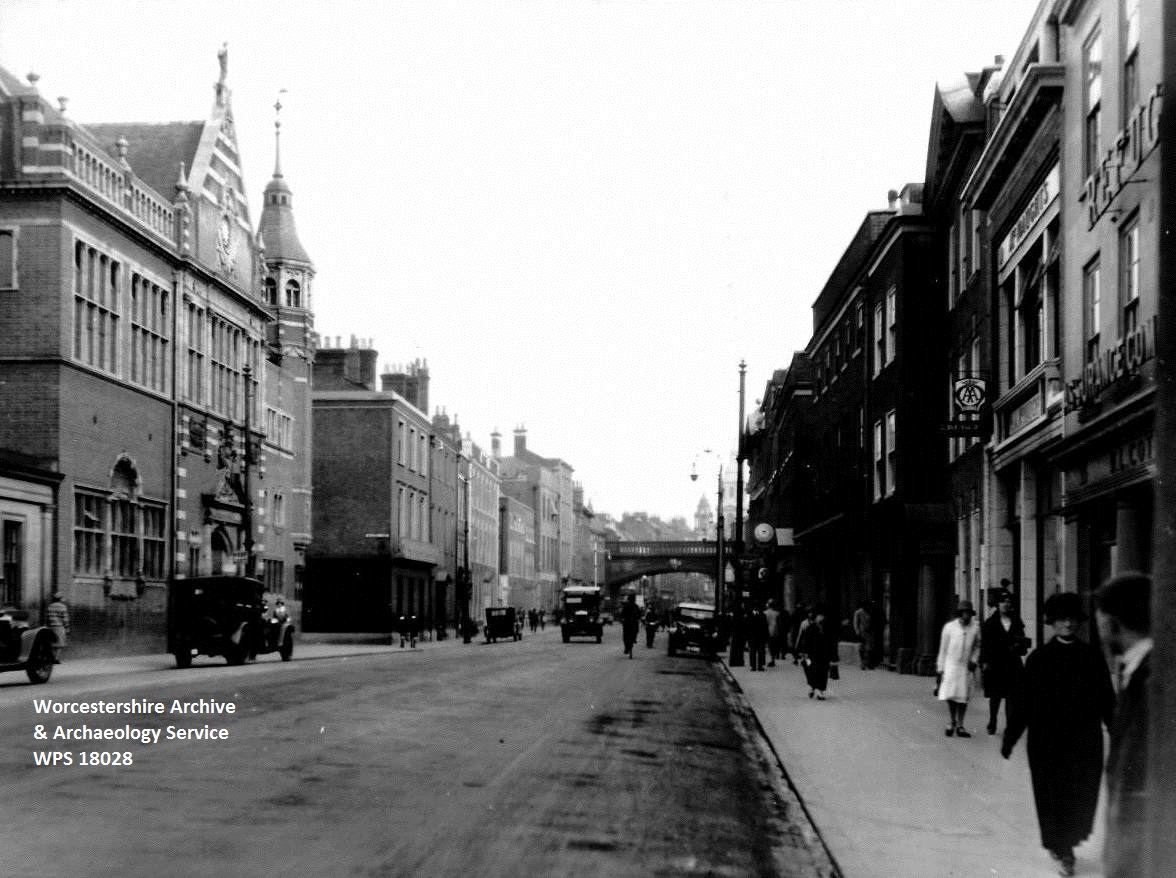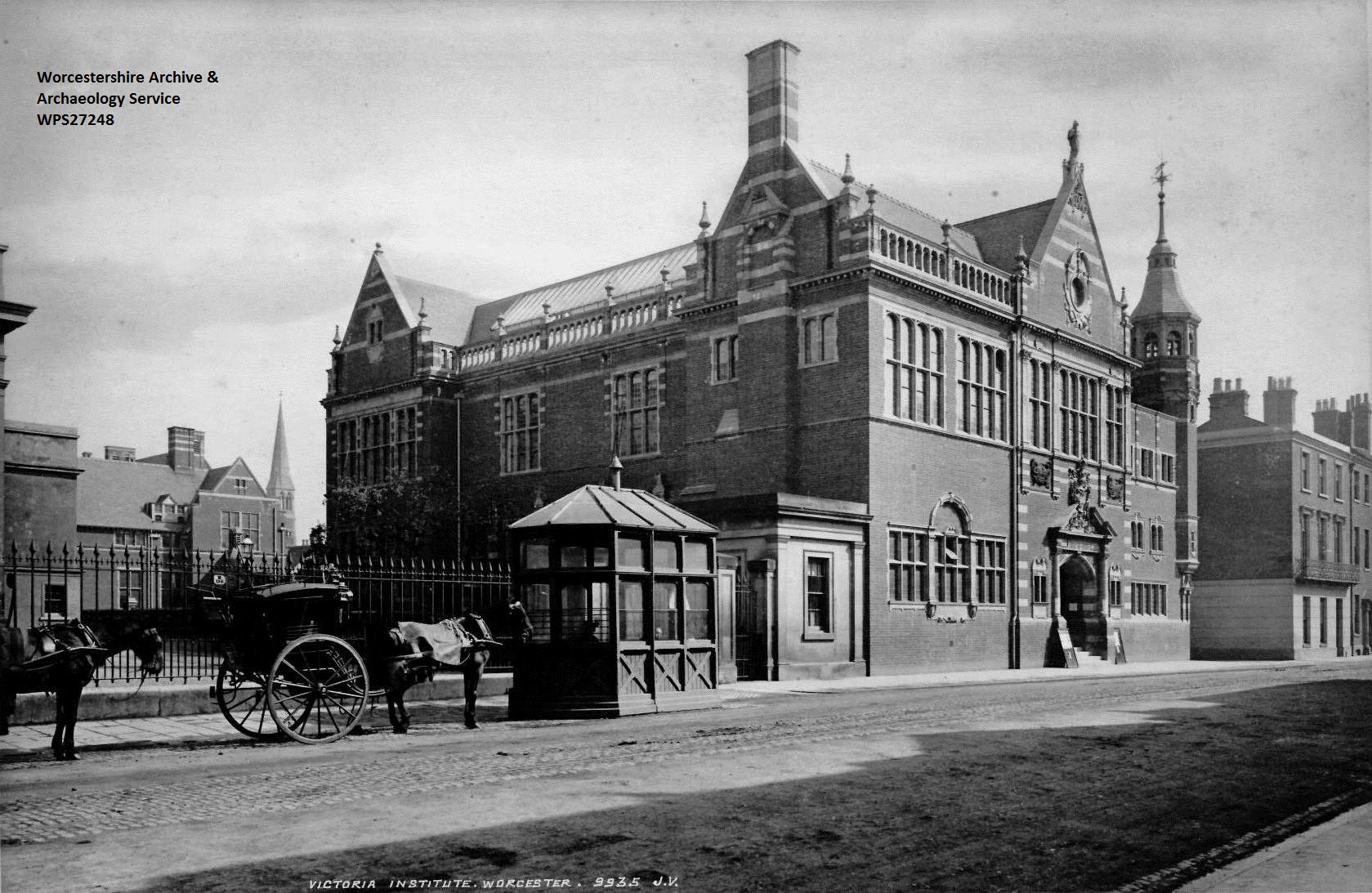Worcestershire Libraries in the Archives
- 8th August 2019
Books are not only vital for education, but provide much needed recreation and mental well-being for people from all walks of life, and for many the best and easiest means of access is still through their local library. But the ease of access to books we enjoy today was not always the case and that for most people literacy and access to books was not an option until the late 19th century. In this blog we explore the archives which show the opening of first Public Library in Worcester and the creation of Worcestershire Library Services to celebrate reading this summer.
 The Victoria Institute, home to Worcester Library (and museum) 1920. Photo by W.Dowty |
| Celebrations of reading are a common aspect of modern education; we celebrate World Book Day at the beginning of March and International World Book Day on April the 23rd as well as the Summer Reading Challenges here at the Hive. We are reminded however that this ease of access to books was not always the case and that for most people literacy and access to books was not an option until the late 19th century. Books are not only vital for education, but provide much needed recreation and mental well-being for people from all walks of life, and for many the best and easiest means of access is still through their local library. This blog will explore the archives which show the opening of first Public Library in Worcester and the creation of Worcestershire Library Services.
The first public library for Worcester City which was free at the point of use was opened in 1879 following the Public Libraries Acts of 1850 and 1855. Other towns in the county also set up their own libraries; Kidderminster opened a library 1855 although the books could not be borrowed until 1882, Evesham in 1897 and both Malvern and Stourbridge in 1902. This new law allowed local authorities to provide libraries funded through local rates in towns and cities with populations of over 10,000 and this population restriction was lowered to 5,000 in 1855. The goal of opening of public libraries was threefold. 1. First by providing access to knowledge it would educate the motivated working classes through self-improvement and lead to social mobilisation. 2. Secondly the library provided recreational activities and spaces through books, newspapers and classes. 3. Thirdly libraries also aimed to support mental well-being to borrow a modern phrase by combatting the stresses and isolation of an increasingly industrialised and urbanised society. In Worcester City the Library Committee and Library Building Committee were set up by the City Corporation in 1879 to investigate the opening of the first free public library in the city under the Act of 1855. Earlier libraries had existed in the city, there was a Worcester Library established in 1790 for example, however were usually subscription libraries which many could not afford to access as you needed to pay to access the books. The first task of the Committees was to find a building for the library. The Worcester Museum Society offered to sell their building on Foregate Street to the Worcester Corporation to use for the Library. However the Worcestershire Natural History Society, who was using the space, only agreed to give up their lease on three provisions: 1. that their collections were displayed; 2. that the name Charles Hastings, who was a consultant at Worcester Infirmary, president of the Worcestershire Medical Society and had helped set up the British Medical Association, continued to be used for the museum; 3. that their curator was employed by the Corporation at the same wage. After agreeing with these requirements the building became both a Library and Museum on the site of what is today the Odeon cinema.  Victoria Institute c1910 The cost of the building to the City Corporation was £3270 in 1880 which would be roughly £216,424 today, but that was not all it cost because the building needed refurbishment. An architecture firm Freeman and Naylor of Derby was used to design the alterations and a local firm, Messrs Frederick Wells and Son of Foregate Street, won the tender for the work competing against 3 other companies, they were paid £1034:8s:6d pence which would be about £68,463 today. Once the work was complete the library was officially opened to the public for the first time on the 16th March 1881 by the Honourable J. Russell Lowell an American romantic poet, critic, editor, and diplomat as well as Thomas Rowley Hill Esq. the M.P. for Worcestershire at the time. In 1896 however Worcester Library and Hastings Museum moved across the road to a purpose built building which still houses the Worcester City Art Gallery and Museum. Outside of major towns the provision of libraries was limited; that is until the Public Libraries Act of 1919 which put the provision of a county library service under the control of County Councils. Worcestershire County Library Services were established by Worcestershire County Council in 1920 with the help of the Carnegie United Kingdom Trust (C.U.K.T.) which was formed in 1913 to promote library services in rural areas. C.U.K.T. provided a grant of £1,400, about £40,680 today, for the shelving, boxes and the first supply of books. The Council needed to find £300, about £8,717, for the salary of a Librarian, the running costs and new books. The first County Librarian, Miss S. F. Fergusson was chosen from over 300 applicants and appointed from the 1st October 1923. Miss Fergusson co-ordinated Library centres across the county from the headquarters “under the eaves, up three flights of twisting narrow stairs” in 37 Foregate Street. These library centres were small collections of books (on average about 40 which changed about 3 times a year) in rural villages which were looked after by a voluntary ‘Local Librarian’, often this was the headmaster of the local school but when there was not school, a member of the local W.I. or someone important in the community would take on the role. The buildings they used for the library space ranged from the local village school or W.I. hall to the local pub and some were very cramped and not fit for purpose. Miss Fergusson was expected to cycle to visit these centres and travel with the lorry swap over the books at each of these. In 1924 there were 46 centres however by 1928 there were 168 centres in the County and it was decided to combine some of these in areas with larger populations into branch libraries such as Stourbridge, Stourport and Droitwich which were opened in the early 1930s and Pershore in 1939. There were however still 180 village centres in 1954. The next development came after the Second World War when in 1948 experiments in using a mobile library van started. In Worcestershire the first van was a ‘second-hand “box-van”, which was originally a “Bulmer’s Cider” wagon’, this van transported trestle tables and books around the county. The scheme was bought into operation in 1949 and by 1965 there were 4 mobile libraries. A mobile van reduced the need for the village centres and by 1965 there were only 21 left. The next development was in the 1960s with the Public Libraries and Museums Act 1964 which would mean libraries serving less than 40,000 people would be unable to run independently and therefore become part of the County Service. These also ensured members of one library could access those from other areas in the county without charge. Finally with the Local government reorganisation of 1974 the libraries all became part of the County Council Service. |
Of course today the libraries continue to be sources of recreation and education as well as providing access to the internet and online resources which broadens their use beyond the books and building. We need to value

The Hive – the current home to Worcester Library, as well as the University library and ourselves!
| To find out about library services in Worcestershire today please see the links below:
http://www.worcestershire.gov.uk/libraries http://www.thehiveworcester.org/ References: Black, Alistair; Hoare, Peter eds. (2006) The Cambridge History of Libraries in Britain and Ireland Volume 3: 1850-2000 Nauta, M. F. ed. (1973) Records and Recollections 1923-1973 Library Reference: L027.442 Some of our archive collections relating to the library services: Worcester City Collections: b496.5 BA9360 /A18/20 – City Corporation Order Books b496.5 BA9360 A7/Box 1 and 2 – Library Committee and Library Building Committee minute books Worcestershire Library Service Collections: 250.601 BA1060/1-7 Library Sub Committee 469.02 BA10246/9(ii) County Library Service Early Development If you are interested in how we worked out how much it would have cost today see the National Archives Currency Converter at the link below. |
the great services the libraries provide so that they can continue to provide them for years to come.
Alice
Post a Comment